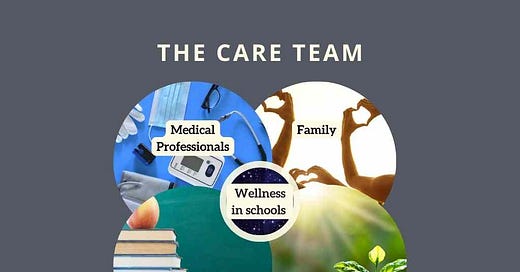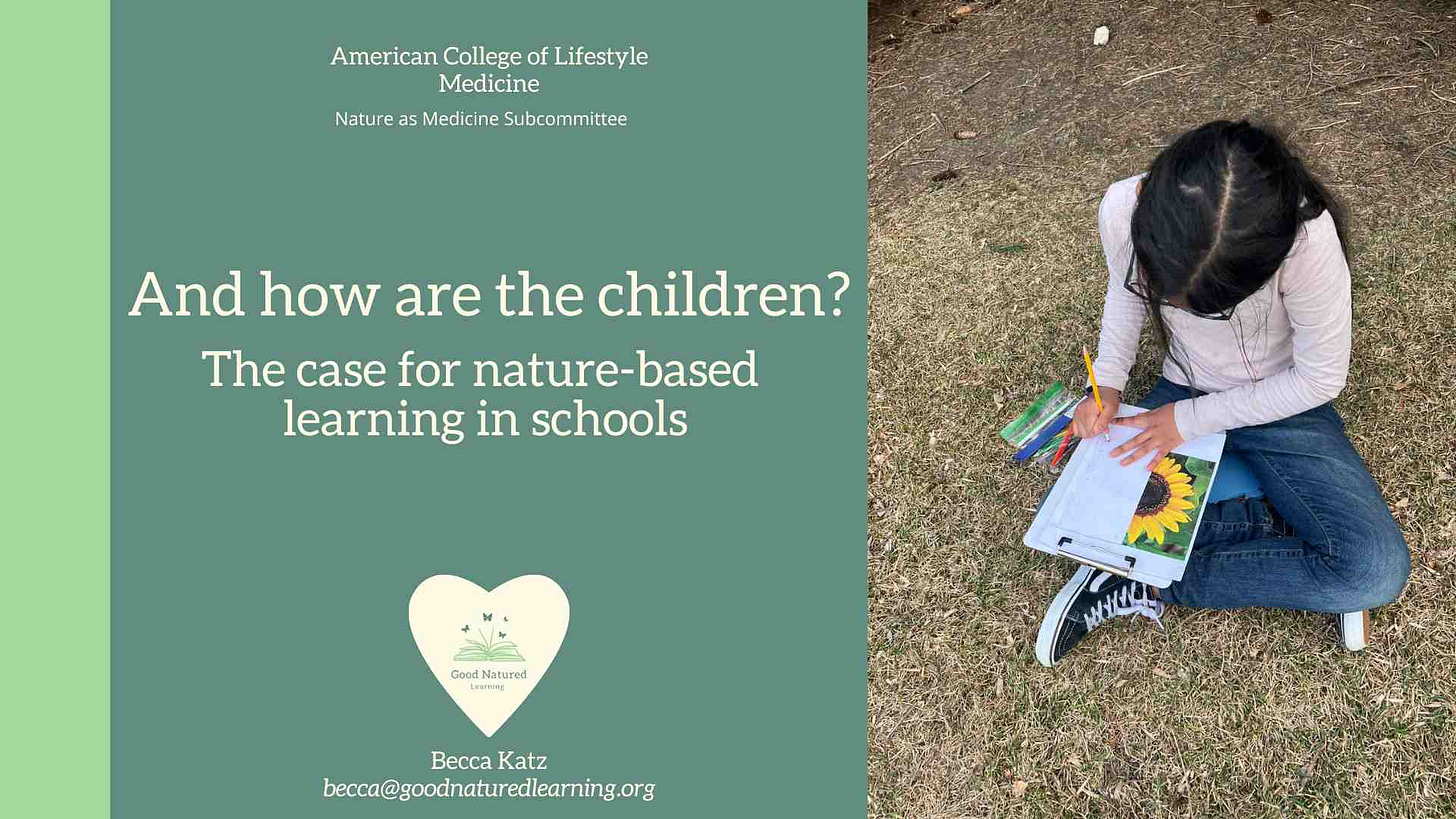A few weeks ago, I spoke to the nature-as-medicine (NAM) member-interest group of the American College of Lifestyle Medicine. I am grateful to @DrOutdoors Melissa Sundermann for the invitation and I am over-the-🌙 that these health professionals are curious how their work connects to education.
When it comes to children, educators and health professionals are more than connected. They are inextricably linked. Or they should be. And families. And nature 🌱 too. Most striking in our conversation was the empathy we shared when it came to reasons to integrate nature-as-medicine into the health industry and the reasons to integrate nature connection in schools. What’s more: the barriers we face are remarkably similar, too. What follows is an adapted version of what we explored together.
Dear Health Professionals,
Kasserian ingera? And how are the children?
This traditional Maasai greeting replaces the more individual and now-focused, “How are you?” or “How’s it going?”
Imagine having that question lobbed at you while passing on the street or bumping into an acquaintance at the grocery store.
Just the idea of it stops me in my tracks. A gut-punch question about what really matters. In just two words (five in translation), this query invokes and invites consideration of community-wide, intergenerational wellbeing. And, by extension, 🌍❤️🩹planetary wellbeing.
Do you have time to listen (read) and actually hear my answer?
Kasserian ingera? And how are the children?
Not Well
The children are not well. Chief complaint? 🧠❤️🩹Mental health (wrote about that here).
The 💪❤️🩹physical health picture is also grim. According to the Center for Disease Control, in the U.S., almost 1 in 5 children and adolescents ages 2-19 suffer from obesity. 1 in 12 children ages 0-17 years have asthma (with rates much higher among children of color, attributed in part to environmental injustices like living near freeways and factories). From 2001 to 2017, the number of people under age 20 living with type 2 diabetes grew by 95%.
I know. Anyone can find troubling stats for any topic at any moment in history (probably the future, too). And, you’d be right. If we go rotten cherry 🍒 picking we can surface dark statistics about anything at any time. Even in areas we know there are plenty of improvements. For example, there are ways children are – on average – better off now. In the U.S., we can tip our hats to advances like civil rights, greater educational access, vaccines, and improved access to healthcare. To the abolishment of child labor. In the same breath, we must acknowledge the significant disparities in health, education, rights, and quality of life enjoyed by some children (i.e., White, affluent, cis-gender, hetero) compared with others (i.e., children on-the-margins due to systemic injustices including, especially, BIPOC children, children living in poverty, and LGBTQIA+ children).
Still, relative and measured as they are, there are some areas in which most would agree we’ve made progress.
So I ask again,
Kasserian ingera? And how are the children?
They Could be Better
If we factor in the subjective and uneven nature of progress – and of how researchers have been spotting troubling trends for as long as we’ve been paying attention – I must offer a more nuanced answer to our central question.
Kasserian injera? And how are the children?
They could be better. And I know one solution to make this better a reality.
It’s about expanding the care team to include some new members:
🏥🩺🥼 You all. Health professionals. Because you’re healers.
🏫🍎📚 And educators. Educators are healers, too.
👨👩👧👦 👪 👩👩👧👦 And family. These folks are definitely part of the team
🌲🌿🌱 And nature. The first and best healer.
If we put together these 4 healers in a Venn Diagram in schools, we get to the wellbeing sweet spot, imploring us to collaborate.
I see this happening in three ways (maybe you have others too?):
Clinical Care in Schools: I love things like school-based health centers where students (and sometimes their families) can get their medical, dental, and behavioral health needs met during the school day at affordable or free rates. I also think it’s great there’s more funding available for school social workers and psychologists.
But let’s not be fools, here. (Warning: ALL-CAPS coming soon.) These supports WILL NOT STEM THE TIDAL WAVE of problems. At best, the ratios are off. Coverage is far from universal. The number of kids in need of care vastly outpaces the number of providers and school-based health centers are few and far between.
“We are not going to be able to build our way out of this crisis,” she said. “We are not going to be able to build enough beds.”
—Dr. K. Ron-Li Liaw, Chief of Mental Health, Children’s Hospital Colorado
Even adequate funding, far from guaranteed, is no bulwark against this problem. Case in point: our local school district in rural Colorado had 4 FULLY-FUNDED SCHOOL SOCIAL WORKER POSITIONS OPEN ALL OF THE 2022-2023 SCHOOL YEAR! This meant students didn’t have access to clinical behavioral health professionals. It also meant other peeps in students’ daily lives (guidance counselors, teachers) ended up doing double duty without training, support, compensation, and at a huge personal toll that leads to burnout and turnover.
Which means students have fewer sustained connections with trusted adults in their lives.
Which means they lose that protective factor just at the moment they need it most, exacerbating the conditions for which they were seeking care in the first place.
🆘 This is a crisis. No rotten cherry picking. Just rotten.
Preventive (non-clinical and clinical) Care in Schools: Schools already try to integrate preventive, non-clinical care. My daughter’s preschool class learned about brushing teeth and hand washing and good stuff like that. Things like physical education (PE) classes – where they haven’t been cut – strive to set up students with healthy habits for life. Health class, too. Those things acknowledged, I also see opportunities here for visits from health professionals – especially lifestyle medicine peeps – who can provide guidance on developing lifelong healthy behaviors related to sleep, social connection, nutrition, and more.
Nature-as-Medicine — in schools, in health care settings, at home: @Dr. Outdoors, Melissa Sundermann, is advocating for nature-as-medicine (NAM). She and her colleagues at the @American College of Lifestyle Medicine want “Daily Exposure to Nature/Fresh Air” to be added as a 7th official pillar of lifestyle medicine. Their work is grounded in a growing mountain of evidence. Just 120 minutes a week of nature can lead to better wellbeing.
ALL EDUCATORS CAN PRACTICE NATURE-AS-MEDICINE. We can creatively Venn a care team together in formal education settings by integrating nature-based learning practices1 as part of educators’ routine instruction. As part of classroom design. We can advocate for access to nearby nature2 through nature-based learning design3.
With this strategy, everyone in schools – students and educators alike – can get their weekly 120 minutes of NAM and its multitude of associated benefits (read: improved mental and physical wellbeing, enhanced socio-emotional skills, better cognitive function).
What’s more, ALL FAMILIES CAN PRACTICE NATURE-AS-MEDICINE. And they’re much more likely to do this when students come home from school with a favorite sit-spot under a tree or an abiding attachment to their neighborhood park. And when health professionals in their kids’ life start prescribing time outdoors.
This is all connected.
It can be done
THIS STRATEGY IS POSSIBLE — especially nature-as-medicine in schools. Nature-based learning is a low-cost, low-risk, attainable intervention. With a little nudge, students could get 120 minutes/week of NAM in every school across the U.S. Arguably across the globe. This could happen by the start of the next school year. We just have to want it. Then, we can have an uplifting answer to the question:
Kasserian injera? And how are the children?
They’re much better. Thanks to integrating nature-based learning in schools everywhere.
-Becca
Nature-based learning practices are instructional (pedagogical) and classroom design actions to implement nature-based learning.
They can be employed by any educator, anywhere, at any grade level, in any content area, in any curriculum or school design model.
They can be applied in formal (i.e., in schools, during the school day) and informal (i.e., in everyday life) educational settings.
They are within an individual educator’s locus of control to implement.
Nearby nature includes outdoor spaces accessible from school buildings by human-powered locomotion (e.g., walking, rolling, biking, etc.).
Nature-based learning design is a systems-change framework that applies nature-based learning principles and priorities (like access to nature) to the systems that directly and indirectly impact education so more students and educators experience nature’s benefits.






Wow! What a great article. As a previous peds nurse and member of NAM, your interactive & fun talk with our group was phenomenal and I am so happy to see how you expressed your thoughts so eloquently here. Thanks Becca for your attention to this important issue.
I believe the most serious issue--the life-threatening isssue--is the 56% of youth experiencing trauma from the prospect of a failed planet in 2050. Imagine thinking ahead to adulthood under that threat. Imagine being told daily to do your Algebra homework so you can get into a good college so you can get a job that may not exist. Unless 'the children' have an opportunity for action to shift the future, the trauma will increase. So will the other health symptoms, which are really signs of a deteriorating society.